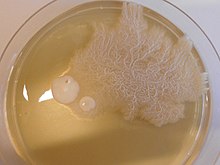双态性真菌是在不同环境温度下改变其形态的真菌,绝大多数属于阿耶洛双态菌科。[1] 这些真菌在环境温度下以霉菌/菌丝/的丝状形态繁殖 [2],在人体或高温培养条件下则以孤立的酵母形式芽生繁殖。一个例子就是导致艾滋病患者机会性感染的新埃蒙斯菌属: 在室温下,它作为一个霉菌生长,在体温下,它作为一个酵母生长。[1]
 作为酵母细胞和丝状(菌丝)细胞生长的白色念珠菌(Candida albicans)
作为酵母细胞和丝状(菌丝)细胞生长的白色念珠菌(Candida albicans)
双态性真菌的生态学[编辑]
一些物种是人类和其他动物重要的病原体,包括阿耶洛双态菌科的粗球孢子菌 [3],副球孢子菌属,芽生孢子菌属(Blastomyces dermatitidis),荚膜组织胞浆菌(Histoplasma capsulatum)和新埃蒙斯菌属等。[4] [5] 其它菌种如申克氏孢子丝菌(Sporothrix schenckii),马尔尼菲青霉菌,曲霉属,隐球菌属以及某些植物病原体玉米黑粉菌(Ustilago maydis) 和芝士制真菌白地霉(Geotrichum candidum)也具有双态性生命周期。
白念珠菌 [6] 虽然是双态性真菌,但他们的转换方式与其它双态菌正好相反,在环境温度下为酵母样,在人体环境下(巨噬细胞)内呈菌丝,这种双态性与其致病毒力有关。
参考文献[编辑]
- ^ 1.0 1.1 Jiang, Y., Dukik, K., Muñoz, J.F.; et al. Phylogeny, ecology and taxonomy of systemic pathogens and their relatives in Ajellomycetaceae (Onygenales): Blastomyces, Emergomyces, Emmonsia, Emmonsiellopsis. Fungal Diversity 90, 245–291 (2018).. [2021-03-09]. (原始内容存档于2021-04-11).
- ^ Fungi. [2009-06-06]. (原始内容存档于2009-06-06).
- ^ Dimorphic Fungi. [2007-08-19]. (原始内容存档于2007-08-18).
- ^ Kenyon; et al. A Dimorphic Fungus Causing Disseminated Infection in South Africa. The New England Journal of Medicine. October 10, 2013, (N Engl J Med 2013; 369:1416-1424) [October 10, 2013]. doi:10.1056/NEJMoa1215460. (原始内容存档于2021-04-11).
- ^ Klein BS, Tebbets B. Dimorphism and virulence in fungi. Curr Opin Microbiol. 2007;10(4):314-319. doi:10.1016/j.mib.2007.04.002. [2021-03-09]. (原始内容存档于2021-04-11).
- ^ Sánchez-martínez, Cristina; Pérez-martín, José. Dimorphism in fungal pathogens: Candida albicans and Ustilago maydis—similar inputs, different outputs. Current Opinion in Microbiology. 2001, 4 (2): 214–221 [2013-12-30]. PMID 11282479. doi:10.1016/S1369-5274(00)00191-0. (原始内容存档于2009-10-23).


